tow SKODA SUPERB 2009 2.G / (B6/3T) Workshop Manual
[x] Cancel search | Manufacturer: SKODA, Model Year: 2009, Model line: SUPERB, Model: SKODA SUPERB 2009 2.G / (B6/3T)Pages: 294, PDF Size: 21.33 MB
Page 128 of 294
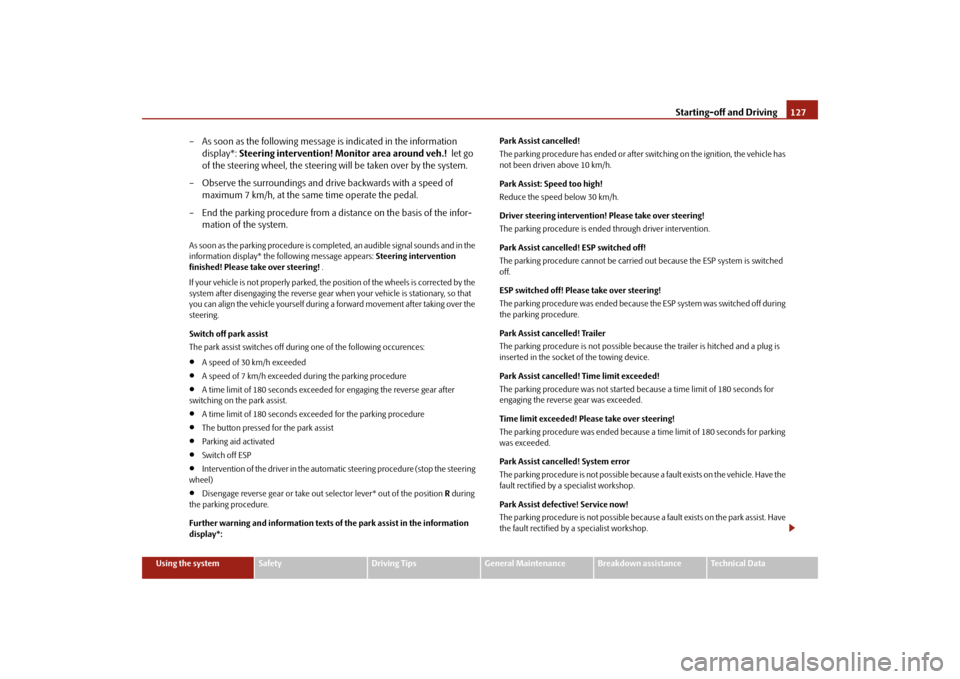
Starting-off and Driving
127
Using the system
Safety
Driving Tips
General Maintenance
Breakdown assistance
Technical Data
– As soon as the following message is indicated in the information
display*:
Steering intervention! M
onitor area around veh.!
let go
of the steering wheel, the steering will be taken over by the system.
– Observe the surroundings and drive backwards with a speed of
maximum 7 km/h, at the same time operate the pedal.
– End the parking procedure from a distance on the basis of the infor-
mation of the system.
As soon as the parking procedure is completed, an audible signal sounds and in the information display* the following message appears:
Steering intervention
finished! Please take over steering!
.
If your vehicle is not proper
ly parked, the position of th
e wheels is corrected by the
system after disengaging the reverse gear when your vehicle is stationary, so that you can align the vehicle yourself during
a forward movement after taking over the
steering. Switch off park assist The park assist switches off during
one of the following occurences:
•
A speed of 30 km/h exceeded
•
A speed of 7 km/h exceeded during the parking procedure
•
A time limit of 180 seconds exceeded
for engaging the reverse gear after
switching on the park assist.•
A time limit of 180 seconds exceeded for the parking procedure
•
The button pressed
for the park assist
•
Parking aid activated
•
Switch off ESP
•
Intervention of the driver in the automatic steering procedure (stop the steering
wheel)•
Disengage reverse gear or take out selector lever* out of the position
R during
the parking procedure. Further warning and information texts of the park assist in the information display*:
Park Assist cancelled! The parking procedure has ended or after sw
itching on the ignition, the vehicle has
not been driven above 10 km/h. Park Assist: Speed too high! Reduce the speed below 30 km/h. Driver steering intervention!
Please take over steering!
The parking procedure is ended through driver intervention. Park Assist cancelled! ESP switched off! The parking procedure cannot be carried ou
t because the ESP system is switched
off. ESP switched off! Please take over steering! The parking procedure was ended because th
e ESP system was switched off during
the parking procedure. Park Assist cancelled! Trailer The parking procedure is not possible becaus
e the trailer is hitched and a plug is
inserted in the socket of the towing device. Park Assist cancelled! Time limit exceeded! The parking procedure was not started because a time limit of 180 seconds for engaging the reverse gear was exceeded. Time limit exceeded! Please take over steering! The parking procedure was ended because a
time limit of 180 seconds for parking
was exceeded. Park Assist cancelled! System error The parking procedure is not possible because a fault exists on the vehicle. Have the fault rectified by a specialist workshop. Park Assist defective! Service now! The parking procedure is not possible because
a fault exists on the park assist. Have
the fault rectified by a specialist workshop.
s2dk.1.book Page 127 Wednesday, April 8, 2009 12:23 PM
Page 134 of 294
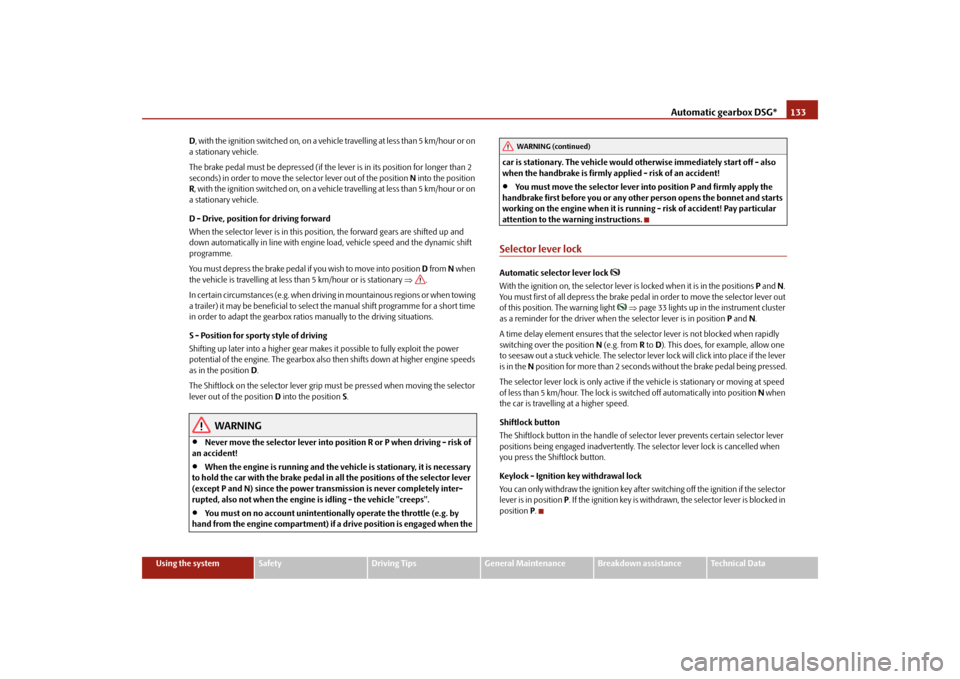
Automatic gearbox DSG*
133
Using the system
Safety
Driving Tips
General Maintenance
Breakdown assistance
Technical Data
D , with the ignition switched on, on a vehicle travelling at less than 5 km/hour or on a stationary vehicle. The brake pedal must be depressed (if the le
ver is in its position for longer than 2
seconds) in order to move the selector lever out of the position
N into the position
R , with the ignition switched on, on a vehicl
e travelling at less than 5 km/hour or on
a stationary vehicle. D - Drive, position for driving forward When the selector lever is in this position, the forward gears are shifted up and down automatically in line with engine
load, vehicle speed and the dynamic shift
programme. You must depress the brake pedal if
you wish to move into position
D from
N when
the vehicle is travelling at less than 5 km/hour or is stationary
⇒
.
In certain circumstances (e.g. when driving
in mountainous regions or when towing
a trailer) it may be beneficial to select
the manual shift programme for a short time
in order to adapt the gearbox ratios
manually to the driving situations.
S - Position for sporty style of driving Shifting up later into a higher gear makes it possible to fully exploit the power potential of the engine. The gearbox also then shifts down at higher engine speeds as in the position
D.
The Shiftlock on the selector lever grip must be pressed when moving the selector lever out of the position
D into the position
S.
WARNING
•
Never move the selector lever into position R or P when driving - risk of
an accident!•
When the engine is running and the vehicle is stationary, it is necessary
to hold the car with the brake pedal in all the positions of the selector lever (except P and N) since the power transmission is never completely inter- rupted, also not when the engine
is idling - the vehicle "creeps".
•
You must on no account unintentionally operate the throttle (e.g. by
hand from the engine compartment) if
a drive position is engaged when the
car is stationary. The vehicle would ot
herwise immediately start off - also
when the handbrake is firmly applied - risk of an accident!•
You must move the selector lever into position P and firmly apply the
handbrake first before you or any othe
r person opens the
bonnet and starts
working on the engine when it is runn
ing - risk of accident! Pay particular
attention to the warning instructions.Selector lever lockAutomatic selector lever lock
With the ignition on, the selector lever is locked when it is in the positions
P and
N.
You must first of all depress the brake pedal in order to move the selector lever out of this position. The warning light
⇒page 33 lights up in the instrument cluster
as a reminder for the driver when the selector lever is in position
P and
N.
A time delay element ensures that the sele
ctor lever is not blocked when rapidly
switching over the position
N (e.g. from
R to D). This does, for example, allow one
to seesaw out a stuck vehicle. The selector
lever lock will click into place if the lever
is in the
N position for more than 2 seconds
without the brake pedal being pressed.
The selector lever lock is only active if th
e vehicle is stationary
or moving at speed
of less than 5 km/hour. The lock is switched off automatically into position
N when
the car is travelling at a higher speed. Shiftlock button The Shiftlock button in the handle of select
or lever prevents certain selector lever
positions being engaged inadvertently. The
selector lever lock is cancelled when
you press the Shiftlock button. Keylock - Ignition key withdrawal lock You can only withdraw the ignition key after switching off the ignition if the selector lever is in position
P. If the ignition key is withdrawn, the selector lever is blocked in
position
P.
WARNING (continued)
s2dk.1.book Page 133 Wednesday, April 8, 2009 12:23 PM
Page 137 of 294
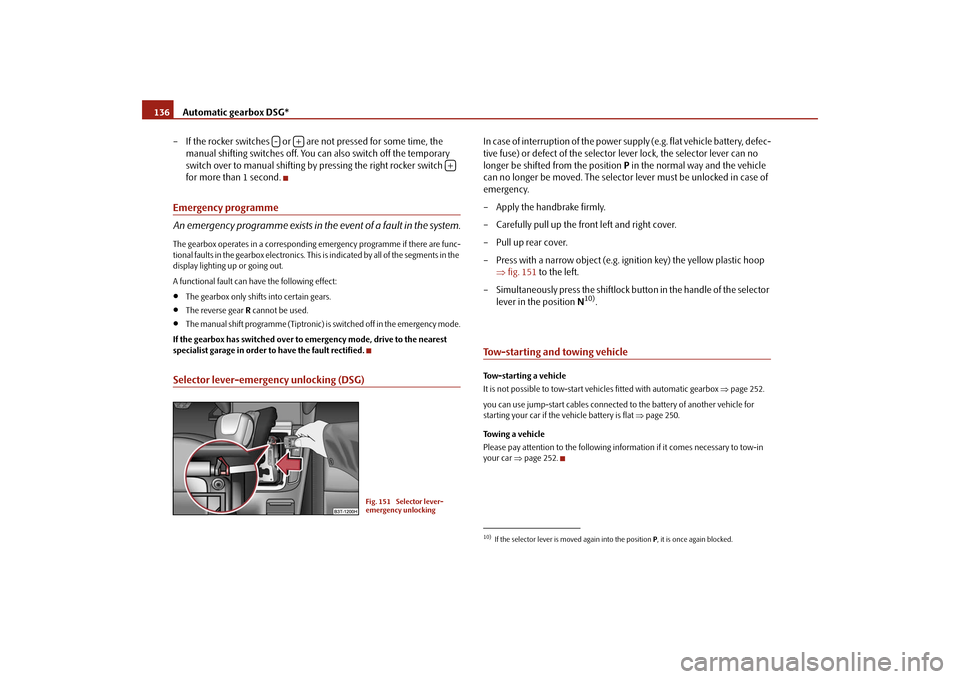
Automatic gearbox DSG*
136
– If the rocker switches or are not pressed for some time, the
manual shifting switches off. You can also switch off the temporary switch over to manual shifting by
pressing the right rocker switch
for more than 1 second.
Emergency programme An emergency programme exists in the event of a fault in the system.The gearbox operates in a corresponding emergency programme if there are func- tional faults in the gearbox electronics. This
is indicated by all of the segments in the
display lighting up or going out. A functional fault can ha
ve the following effect:
•
The gearbox only shifts into certain gears.
•
The reverse gear
R cannot be used.
•
The manual shift programme (Tiptronic) is switched off in the emergency mode.
If the gearbox has switched over to
emergency mode, drive to the nearest
specialist garage in order to
have the fault rectified.
Selector lever-emergency unlocking (DSG)
In case of interruption of the power
supply (e.g. flat vehicle battery, defec-
tive fuse) or defect of the selector
lever lock, the sele
ctor lever can no
longer be shifted from the position
P in the normal way and the vehicle
can no longer be moved. The selector lever must be unlocked in case of emergency. – Apply the handbrake firmly. – Carefully pull up the front left and right cover.– Pull up rear cover. – Press with a narrow object (e.g. ignition key) the yellow plastic hoop
⇒
fig. 151
to the left.
– Simultaneously press the shiftlock bu
tton in the handle of the selector
lever in the position
N10).
Tow-starting and towing vehicle Tow-starting a vehicle It is not possible to tow-start vehi
cles fitted with automatic gearbox
⇒page 252.
you can use jump-start cables connected
to the battery of another vehicle for
starting your car if the vehicle battery is flat
⇒page 250.
Towing a vehicle Please pay attention to the following info
rmation if it comes necessary to tow-in
your car
⇒page 252.
-
+
+
Fig. 151 Selector lever- emergency unlocking
10)If the selector lever is moved again into the position
P, it is once again blocked.
s2dk.1.book Page 136 Wednesday, April 8, 2009 12:23 PM
Page 169 of 294
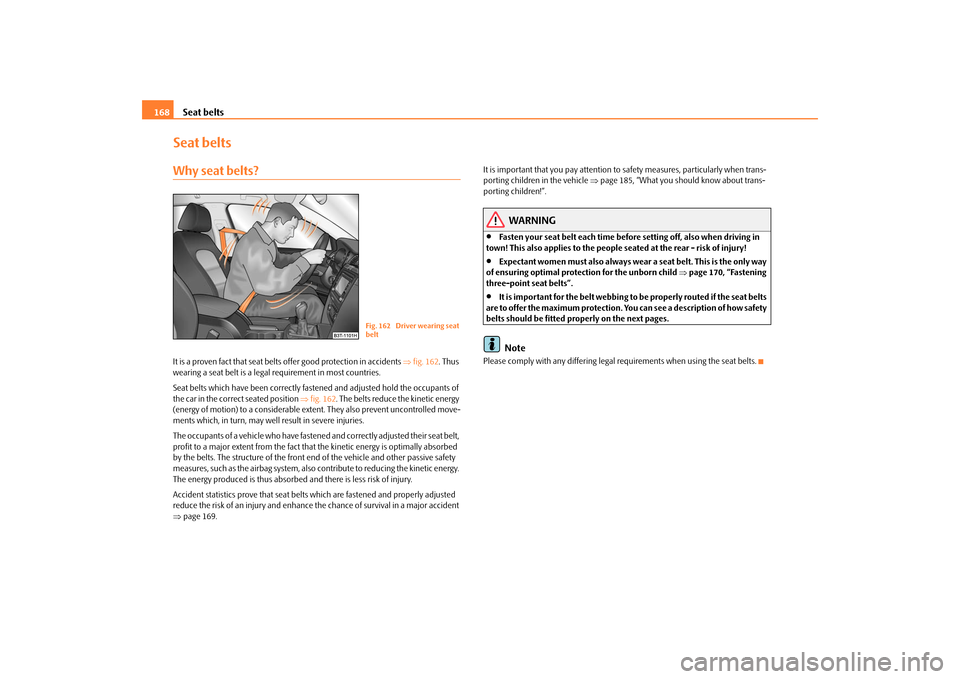
Seat belts
168
Seat beltsWhy seat belts?It is a proven fact that seat belt
s offer good protection in accidents
⇒fig. 162
. Thus
wearing a seat belt is a legal requirement in most countries. Seat belts which have been correctly fastened and adjusted hold the occupants of the car in the correc
t seated position
⇒fig. 162
. The belts reduce the kinetic energy
(energy of motion) to a considerable extent. They also prevent uncontrolled move-ments which, in turn, may well result in severe injuries. The occupants of a vehicle who have fastened
and correctly adjusted their seat belt,
profit to a major extent from the fact that
the kinetic energy is optimally absorbed
by the belts. The structure of the front end of the vehicle and other passive safety measures, such as the airbag system, also
contribute to reducing the kinetic energy.
The energy produced is thus absorbed and there is less risk of injury. Accident statistics prove that seat belts
which are fastened and properly adjusted
reduce the risk of an injury and enhance the chance of survival in a major accident ⇒ page 169.
It is important that you pay attention to
safety measures, particularly when trans-
porting children in the vehicle
⇒page 185, “What you should know about trans-
porting children!”.
WARNING
•
Fasten your seat belt each time before setting off, also when driving in
town! This also applies to the people seated at the rear - risk of injury!•
Expectant women must also always wear
a seat belt. This is the only way
of ensuring optimal protection for the unborn child
⇒page 170, “Fastening
three-point seat belts”.•
It is important for the belt webbing to
be properly routed if the seat belts
are to offer the maximum protection. You can see a description of how safety belts should be fitted pr
operly on the next pages.
Note
Please comply with any differing legal
requirements when using the seat belts.
Fig. 162 Driver wearing seat belt
s2dk.1.book Page 168 Wednesday, April 8, 2009 12:23 PM
Page 197 of 294
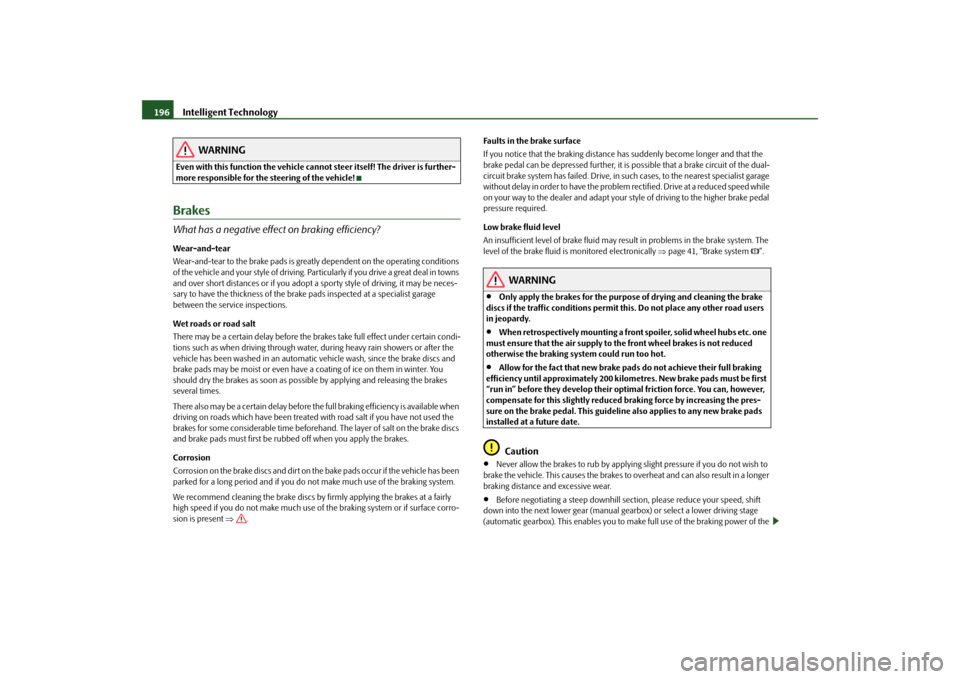
Intelligent Technology
196
WARNING
Even with this function the vehicle ca
nnot steer itself! The
driver is further-
more responsible for the steering of the vehicle!BrakesWhat has a negative effect on braking efficiency?Wear-and-tear Wear-and-tear to the brake pads is greatly dependent on the operating conditions of the vehicle and your style of driving. Particularly if you drive a great deal in towns and over short distances or if you adopt a
sporty style of driving, it may be neces-
sary to have the thickness of the brake
pads inspected at a specialist garage
between the service inspections. Wet roads or road salt There may be a certain delay before the br
akes take full effect under certain condi-
tions such as when driving through water,
during heavy rain
showers or after the
vehicle has been washed in
an automatic vehicle wash, since the brake discs and
brake pads may be moist or even have a
coating of ice on them in winter. You
should dry the brakes as soon as possib
le by applying and releasing the brakes
several times. There also may be a certain delay before the
full braking efficiency is available when
driving on roads which have been treated wi
th road salt if yo
u have not used the
brakes for some considerable time beforeha
nd. The layer of salt on the brake discs
and brake pads must first be rubb
ed off when you apply the brakes.
Corrosion Corrosion on the brake discs and dirt on th
e bake pads occur if
the vehicle has been
parked for a long period and if you do
not make much use of the braking system.
We recommend cleaning the brake discs by
firmly applying the brakes at a fairly
high speed if you do not make much use of the braking system or if surface corro- sion is present
⇒
.
Faults in the brake surface If you notice that the braking distance
has suddenly become longer and that the
brake pedal can be depressed further, it is
possible that a brake circuit of the dual-
circuit brake system has failed. Drive, in such cases, to the nearest specialist garage without delay in order to have the problem rectified. Drive at a reduced speed while on your way to the dealer and adapt your style of driving to the higher brake pedal pressure required. Low brake fluid level An insufficient level of brake fluid may result in problems in the brake system. The level of the brake fluid is monitored electronically
⇒page 41, “Brake system
”.
WARNING
•
Only apply the brakes for the purpos
e of drying and cleaning the brake
discs if the traffic conditions permit this. Do not place any other road users in jeopardy.•
When retrospectively mounting a front
spoiler, solid wheel hubs etc. one
must ensure that the air supply to the front wheel brakes is not reduced otherwise the braking sy
stem could run too hot.
•
Allow for the fact that new brake pads
do not achieve th
eir full braking
efficiency until approximately 200 kilo
metres. New brake pads must be first
“run in” before they develop their optimal friction force. You can, however, compensate for this slightly reduced
braking force by increasing the pres-
sure on the brake pedal. This guidelin
e also applies to any new brake pads
installed at a future date.
Caution
•
Never allow the brakes to ru
b by applying slig
ht pressure if you do not wish to
brake the vehicle. This causes the brakes to overheat and can also result in a longer braking distance and excessive wear.•
Before negotiating a steep downhill sect
ion, please reduce your speed, shift
down into the next lower gear (manual ge
arbox) or select a lower driving stage
(automatic gearbox). This enables you to make full use of the braking power of the
s2dk.1.book Page 196 Wednesday, April 8, 2009 12:23 PM
Page 199 of 294

Intelligent Technology
198
Brake Assist*During a severe brake application (e.g. if a hazard exists), the Brake Assist increases the braking force and thus makes it possible to rapidly produce the pressure required in the brake system. The majority of drivers do
apply the brakes in good time in dangerous situations,
but do not depress the brake pedal with su
fficient pressure. Consequently, it is not
possible for the car to achieve its maxi
mum deceleration and the car covers a
greater distance than necessary. The Brake Assist is activated by the very quick operation of the brake pedal. In such cases, a much greater braking pressure ex
ists than during a normal brake applica-
tion. This makes it possible, even with a relatively low resistance of the brake pedal, to produce an adequate pressure in the brake system in the shortest possible time, which is required for maximum deceleration of the car. You must apply the brake pedal firmly and hold it in
this position in order to achieve the shortest possible
braking distance. The Brake Assist is able to help you achieve a shorter braking distance in emergency situations by rapidly producing the pressure
required in the brake system. It fully
exploits the attributes of the ABS. After you release the brake pedal, the function of the Brake Assist is automatically switched off and the brakes operate in the normal way. The Brake Assist is part of the ESP system. If a fault occurs in the ESP, the Brake Assist function is also not available.
Further information on the ESP
⇒page 193.
WARNING
•
The Brake Assist is also not able to overcome the physical limits of your
car in terms of the braking distance required.•
Adapt your speed to the conditions of the road surface and to the traffic
situation.•
The increased safety offered by the Brake Assist must not tempt you to
take a greater safety risk than otherwise.
Uphill-Start
off-Assist*
The uphill-start off-assist makes it much easier to start off on steep hills. The system assists a start off by holding the brake pr
essure produced by the brake pedal actu-
ation for approx. 2 seconds after releasing the brake pedal. The driver can therefore move his foot from the brake pedal to th
e accelerator pedal and start off on the
slope, without having to actuate the hand
brake. The brake pressure drops gradually
the more you operate the accelerator pedal. If the vehicle does not start off within 2 seconds, it starts to roll back. The uphill-start off-assist is active in the ev
ent of a 5% slope, if the vehicle door is
closed. It is alwa
ys active on slopes when in forward or reverse start off. When
driving downhill, it is inactive.Electromechanical power steeringThe power steering enables you to steer
the vehicle with le
ss physical force.
With the electromechanical power steering, the steering assist is automatically adapted to the speed and to the steering angle. It is still possible to fully steer the vehicle if the power steering fails or if the engine is not running (vehicle being towed in). The
only difference is that greater physical
effort is required. If there is a fault in the power steering, the warning light
or lights up in the
instrument cluster
⇒page 36.
WARNING
Contact your specialist
garage if the power steering is defective.
s2dk.1.book Page 198 Wednesday, April 8, 2009 12:23 PM
Page 200 of 294
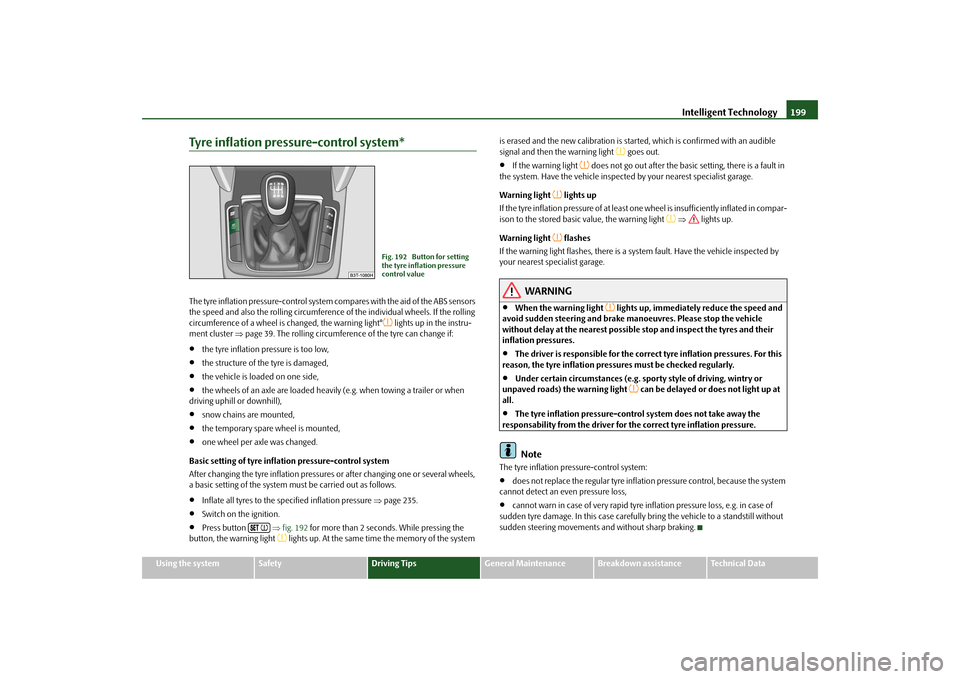
Intelligent Technology
199
Using the system
Safety
Driving Tips
General Maintenance
Breakdown assistance
Technical Data
Tyre inflation pressu
re-control system*
The tyre inflation pressure-control system compares with the aid of the ABS sensors the speed and also the rolling circumference
of the individual wheels. If the rolling
circumference of a wheel is changed, the warning light°
lights up in the instru-
ment cluster
⇒page 39. The rolling circumference of the tyre can change if:
•
the tyre inflation pressure is too low,
•
the structure of the tyre is damaged,
•
the vehicle is loaded on one side,
•
the wheels of an axle are loaded heavily (e.g. when towing a trailer or when
driving uphill or downhill),•
snow chains are mounted,
•
the temporary spare wheel is mounted,
•
one wheel per axle was changed.
Basic setting of tyre inflation pressure-control system After changing the tyre inflation pressures or after changing one or several wheels, a basic setting of the system must be carried out as follows.•
Inflate all tyres to the specified inflation pressure
⇒page 235.
•
Switch on the ignition.
•
Press button
⇒fig. 192
for more than 2 seconds. While pressing the
button, the warning light
lights up. At the same time the memory of the system
is erased and the new calibration is star
ted, which is confirmed with an audible
signal and then the warning light
goes out.
•
If the warning light
does not go out after the basic setting, there is a fault in
the system. Have the vehicle inspected by your nearest specialist garage. Warning light
lights up
If the tyre inflation pressure of at least on
e wheel is insufficiently inflated in compar-
ison to the stored basic value, the warning light
⇒
lights up.
Warning light
flashes
If the warning light flashes, there is a system fault. Have the vehicle inspected by your nearest specialist garage.
WARNING
•
When the warning light
lights up, immediately reduce the speed and
avoid sudden steering and brake mano
euvres. Please stop the vehicle
without delay at the nearest possible stop and inspect the tyres and their inflation pressures.•
The driver is responsible for the correc
t tyre inflation pressures. For this
reason, the tyre inflation pressures must be checked regularly.•
Under certain circumstances (e.g. sporty style of driving, wintry or
unpaved roads) the warning light
can be delayed or does not light up at
all.•
The tyre inflation pressure-control system does not take away the
responsability from the driver for the correct tyre inflation pressure.
Note
The tyre inflation pressure-control system:•
does not replace the regular tyre inflatio
n pressure control, because the system
cannot detect an even pressure loss,•
cannot warn in case of very rapid tyre inflation pressure loss, e.g. in case of
sudden tyre damage. In this
case carefully bring the vehi
cle to a standstill without
sudden steering movements and without sharp braking.
Fig. 192 Button for setting the tyre inflation pressure control value
s2dk.1.book Page 199 Wednesday, April 8, 2009 12:23 PM
Page 202 of 294

Driving and the Environment
201
Using the system
Safety
Driving Tips
General Maintenance
Breakdown assistance
Technical Data
Driving and the EnvironmentA new engineThe engine has to be run in during the first 1 500 kilometres.Up to 1 000 kilometres – Do not drive faster than 3/4 of the mamimum speed of the gear in use,
that is 3/4 of the maximum permissible engine speed.
– Do not use full throttle.– Avoid high engine revolutions. – Do not tow a trailer. From 1 000 up to 1 500 kilometres – Increase the power output of the engine
gradually
up to the full
speed of the gear engaged, that
is up to the maximum permissible
engine revolutions.
During the first operating hours the engine
has higher internal
friction than later
until all of the moving parts have harmonized. The driving style which you adopt during the first approx.1 500 kilometres
plays a decisive part in the success of
running in your car. You should not drive at unnecessarily
high engine revolutions
even after the
running-in period is
complete. The maximum permissib
le engine spee
d is marked
by the beginning of the red zone on the scale of the revolutions counter. Shift up into the next higher gear on a vehicle
fitted with manual gearbox before the red
zone is reached.
Extremely
high engine revolutions are automatically governed, by
the way. For a vehicle fitted with a manual gearbox
the converse situation also applies: Do
not drive at engine revolutions which are
too low
. Shift down as soon as the engine
is no longer running smoothly.
Caution
All the speed and engine revolution figure
s apply only when the engine is at its
normal operating temperature. Never rev up
an engine which is cold, neither when
the vehicle is stationary nor when driving in individual gears.
For the sake of the environment
Not driving at unnecessarily high engine revolutions and shifting to a higher gear as early as possible are ways to minimise fuel consumption and operating noise levels and protects the environment.New tyresNew tyres have to be “run in” since they do
not offer optimal grip at first. You should
take account of this fact for the first 500 kilometres and drive particularly carefully.New brake padsAllow for the fact that new brake pads do
not achieve their full braking efficiency
until approximately 200 kilometres. New brake pads must be first “run in” before they develop their optimal friction force.
You can, however, compensate for this
slightly reduced braking force by increasing the pressure on the brake pedal. This guideline also applies to any new
brake pads installed at a future date.
During the running-in period, you should
avoid excessive stresses on the brakes.
This includes, for example, violent braking,
particularly from very high speeds, and
also when crossing mountain passes.
s2dk.1.book Page 201 Wednesday, April 8, 2009 12:23 PM
Page 203 of 294

Driving and the Environment
202
Catalytic converterProper operation of the emission co
ntrol system (catal
ytic converter)
is of major significance for drivin
g your vehicle in an environmen-
tally conscious way.Please refer to the following guidelines. – For vehicles with petrol engine
only refuel with unleaded petrol
⇒
page 219, “Grades of petrol”.
– Never run the fuel tank completely empty. – Do not switch off the ignition while you are driving the vehicle. – Do not pour too much oil into the engine
⇒
page 225, “Replenishing
engine oil”.
– Do not tow-start the vehicle over a
distance of more than 50 metres
⇒
page 252, “Tow-starting and towing vehicle”.
If you drive your vehi
cle in a country in which unleaded
petrol is not available, you
must have the catalytic converter replaced
later when driving the vehicle into a
country in which use of a cata
lytic converter is mandatory.
WARNING
•
In view of the high temperatures which may be produced in the catalytic
converter, one should always park a vehicle in such a way that the catalytic converter cannot come into contact with
easily flammable materials below
the vehicle - a risk of fire!•
Never use additional underbody protection or corrosion-protection
agents for the exhaust pipes, catalyti
c converters or heat shields. Such
substances might ignite when driving - risk of fire!
Caution
•
Vehicles fitted with
catalytic converter should neve
r be allowed to let the fuel
tank to run completely empty. An irregular
fuel supply can result in poor ignition or
misfiring. Unburnt fuel may get into the exhaust system and damage the catalytic converter.•
Filling the tank even only once with le
aded petrol will resu
lt in the catalytic
converter being destroyed.•
If you detect a power reduction or ir
regular engine runni
ng when driving,
reduce your speed immediately and have the vehicle inspected by the nearest specialist garage. The symptoms described may be caused by a fault in the ignition system. Unburnt fuel may get into the ex
haust system and da
mage the catalytic
converter.
For the sake of the environment
Even if the exhaust system is operating properly, a sulphur-like exhaust odour may be produced under certain op
erating conditions of the en
gine. This depends on the
sulphur content of the fuel. It is often su
fficient to refuel with unleaded premium-
grade petrol of a different brand or at a different filling station.Driving in an economical and environmentally conscious mannerGeneral Your personal style of driving is a major factor.Your fuel consumption, any pollution of
the environmental and the wear-and-tear
to the engine, brakes and tyres, depend essentially on three factors:•
your personal style of driving,
•
the conditions under which
your vehicle is operated,
•
technical aspects.
You can easily improve your fuel economy by 10 - 15 percent by driving in an economical way with foresight. This section is intended to provide you with a number of tips on how to protect the en
vironment and at the same time save
money.
s2dk.1.book Page 202 Wednesday, April 8, 2009 12:23 PM
Page 204 of 294

Driving and the Environment
203
Using the system
Safety
Driving Tips
General Maintenance
Breakdown assistance
Technical Data
The fuel consumption can naturally also be
influenced by factors which are beyond
the driver's control. It is,
for example, normal for the fu
el consumption to increase
in winter and under worsened
conditions such as poor road conditions, towing a
trailer, etc. The technical requirements for low fuel
usage and economic efficiency of the
vehicle have already been built into the ve
hicle at the works.
Special attention has
been given to minimising ne
gative effects on the environment. It is necessary to
take note of the guidelines given in this
chapter in order to make best use of these
characteristics and to maintain their effectiveness. The optimal engine speed should be obtained when accelerating, in order to avoid a high fuel consumption an
d resonance of the vehicle.
Looking ahead when driving A vehicle's highest fuel consumption occurs it accelerates.Avoid accelerating and brakin
g unnecessarily. If you drive
with forsight you will not
need to brake so often and will also then
not have to accelerate so much. Let your
vehicle coast to a stop, for example, if this
is possible, when you see that the next
set of traffic lights is at red.Shifting gears and saving energy Shifting up early saves on fuel.
Manual gearbox – Drive no more than about one length of your vehicle in first gear. – Always shift up into the next higher gear at approx. 2 000 to 2 500 revs. Automatic gearbox – Depress the accelerator pedal
slowly
. Do not depress it beyond the
kickdown position, however.
An effective way of achieving good
fuel economy is to shift up
early
. You will
consume more fuel if you drive at unnecessa
rily high revolutions in any given gear.
The
⇒fig. 194
shows the ratio of fuel consumption to the speed of your vehicle in
the relevant gears. Fuel consumption in 1st
gear is the highest, while that in 5th or
the 6th gear is the lowest. Only depress the accelerator pedal slowly if
your vehicle is fitted with an automatic
gearbox in order to automatically select an economic driving programme. You will achieve good fuel economy by shifting
up early and shifting down late.
Note
Also use the information supplied by the multi-functional indicator*
⇒page 21.
Fig. 194 Fuel consumption in litres/100 km. and speed in km/h.
s2dk.1.book Page 203 Wednesday, April 8, 2009 12:23 PM